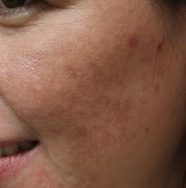
Acne scars can be effectively addressed by producing new and normal collagen density to improve the rest of the skin.*
After dozens of creams and medications, after years of faithfully washing your skin with infomercial cleansers, you’ve finally overcome the severe acne that obstinately covered your face. You feel a powerful sense of relief until soon realizing that pimples and pustules were only the beginning; your face is now pocked with acne scars.
In most cases, acne is temporary. Breakouts eventually subside and heal, either because of an effective treatment or simply because of the person’s growth into adulthood. However, for those unfortunate enough to experience the condition in its severe forms, the resulting acne scars may not go away. They often continue to blemish the skin long after the infection is gone, serving as a telltale sign and haunting reminder of the past.
Types of Acne Scars
In general, acne scars are a result of fibrous tissue replacing normal tissue in an attempt to heal the skin at the breakout site. This means that, while the tissue is all comprised of the same collagen, the composition of the collagen is different where scars appear. A person may suffer from different types of acne scars, to include:
- -Ice pick scars: indented pits
- -Box car scars: marks resembling chicken pox
- -Rolling scars: wave-like appearance of the skin
- -Hypertrophic scars: raised, red bumps similar to keloids
Getting Rid of Acne Scars
Fortunately, a person suffering with acne scars today still has hope of regaining smooth, unflawed skin. Modern technology has developed ways to overcome this unflattering and psychologically damaging ailment. Solutions range from nominally invasive methods to surgery, and include the following:
- -Microdermabrasion: This mild procedure uses tiny particles, such as finely ground magnesium salt crystals, to sand the skin’s surface. This generates the growth of new cells, but does not vastly reduce the appearance of acne scars.
- -Dermabrasion: This procedure uses a textured metallic or diamond fraise surface to actually sand the skin. It is a bloody process, much harsher than microdermabrasion, and has a recovery period up to 8 weeks long. Scarring and discoloration may result.
- -Fraxel laser: Fraxel Repair and Fraxel Dual are two different types of laser treatment that more noticeably improve acne scars, with less risk than dermabrasion. Fraxel Repair uses photo thermolysis while Fraxel Dual normalizes the collagen density of the skin.
